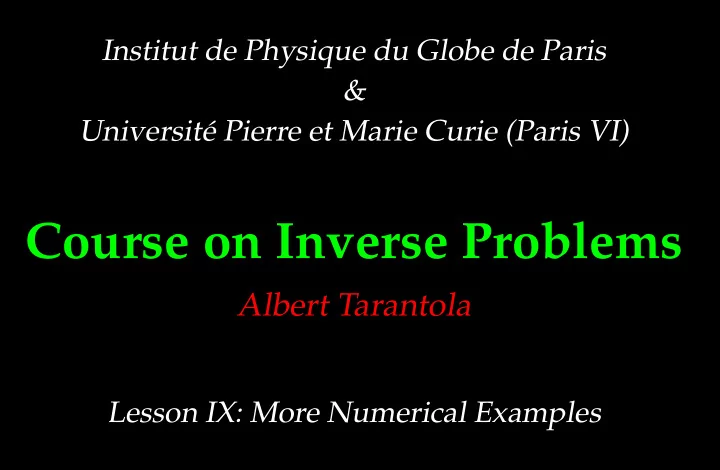

Institut de Physique du Globe de Paris & Université Pierre et Marie Curie (Paris VI) Course on Inverse Problems Albert Tarantola Lesson IX: More Numerical Examples
Fissures and Rifting: The inspiration for this example comes from my work with measuring and interpreting the deforma- tion produced by episodes of rifting in Afar (Tarantola et al., 1979). When a fissure (dyke) opens in a rift valley (because magma produces “hydraulic fracturing”), the surrounding re- gion relaxes elastic stresses, and undergoes elastic deforma- tions. The position, length, orientation, and opening of the fissure, may not be known, because the erupted lava may hide the fissure or because the fissure may be under water (we had both situations in Afar). Using a mechanical model of the Earth crust, and given the position, the length, the orienta- tion, and the value of the opening of the fissure (these are the “model parameters”), one can predict the displacements pro- duced in the region when a fissure opens (this is the “forward problem”). Let us here try to solve the “inverse problem” of estimating the parameters of the fissure, given the observed displacements at a set of geodetic points.
As the use of a realistic three-dimensional, elastic, modelisa- tion code would require more time than that available for this exercise, I will use a dramatically simplified model of defor- mation (where elastic theory, in fact, is not used at all). The Mechanical Model (Solving the Forward Problem) Consider a two-dimensional plane, representing the surface of the (flat) Earth. A horizontal fissure is represented by the coordinates ( X , Y ) of its center, by its length ∆ , the angle ψ corresponding to the azimuth of a vector normal to the fissure, and by the value Q of the opening at the center of the fissure (see next figure).
N ( x , y ) ( X , Y ) α β ψ U n Q = e q ∆ = e δ
As the parameters ∆ and Q are positive, and the statistics of positive parameters are tricky, we rather use the logarithmic parameters δ = log ∆ , q = log Q . Therefore, we have ∆ = e δ , Q = e q . Let ( x , y ) be the coordinates of the point at which we wish to evaluate the displacements produced by the opening of the fissure, and let u be the (horizontal) displacement vector of this point ( x , y ) . Let us simply model this displacement u by assuming that it is
• proportional to the opening of the fissure, Q = e q ; • proportional to f 1 = exp ( − U / ∆ ) , where U is the dis- tance from point ( x , y ) to the center of the fissure, and ∆ is the fissure length; this means that displacements de- cay exponentially away from the fissure, with the fissure length ∆ as the parameter of the exponential decay (an assuredly crude “mechanical” model); • proportional to f 2 = sin 2 α , where α is the azimuth of the point ( x , y ) as seen from the center of the fissure; this, again, is a rather crude way of taking into account the directionality effects; • is colinear to the vector U going from the center of the fissure to the point ( x , y ) (and has the same sense).
Therefore, for the (horizontal) displacement vector at point ( x , y ) , we take the expression u = Q f 1 f 2 U � U � , i.e., u = e q exp ( − U / ∆ ) sin 2 α U . U This has two (horizontal) components, u x , and u y , the norm y ) 1/2 . In addi- of this horizontal vector being u H = ( u 2 x + u 2 tion to this horizontal displacement, there may be a vertical one, that we (simplistically, just for this numerical exercise) assume to equal one-seventh of the horizontal displacement, u z = u H /7 . ⇒ mathematica notebook.
X=5 Y=20 Y=25 X=10 ? X=15
X=5 Y=20 Y=25 X=10 X=15
1.5 km/s < v i < 3.5 km/s z 0 (fxed, z 0 = 0 km) v 1 z 1 ( z 0 < z 1 < 350 km) v 2 z 2 ( z 1 < z 2 < 750 km) v 3 z 3 ( z 2 < z 3 < z 4 ) v 4 z 4 (fxed, z 4 = 1000 km) Using Waveform Data ⇒ mathematica notebook
Recommend
More recommend